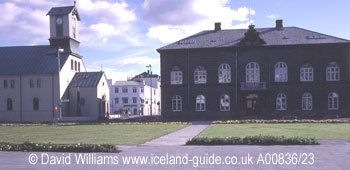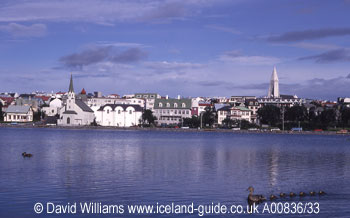 |
| These
are two of Reykjavík`s best-known buildings: on the left is
Dómkirkjan, the Lutheran cathedral and on the right is Althingishúsið,
the Icelandic parliament building. |
 |
| The
picturesque lake of Tjörnin lies near the centre of the city. |
The city`s
historical centre is the square of Austurvöllur, by happy
coincidence the homefield of the country`s first permanent settler, Ingólfur
Árnarson. Ingólfur gave the future capital the name "Reykjavík"
("smokey bay") because of the plumes of warm vapour rising from
the ground. But the usual meaning of the word "smokey" can never
be used to describe the modern city. Heating the buildings by natural
hot water means that there are few chimneys and airborne pollution is
virtually absent. The clean air means that visibility can be superb and
you can often see the ice-capped cone of the volcano Snæfellsjökull
some 120km away. Jules Verne was one of the early travel writers to write
about the country as his intrepid explorers in Journey to the Centre of
the Earth popped into this volcano at the start of their bizarre journey
to emerge later at Stromboli.
Austurvöllur is dominated by a statue of the nineteenth-century patriot
Jon Sigurðsson
and the Althingishúsið,
the Icelandic parliament building. Beside this is a building that would
go unnoticed in other cities, Dómkirkjan, the Lutheran cathedral.
No fancy Gothic structure here, just plain unadorned corrugated iron.
A much older building, and just beyond the other side of the square, is
Fógetinn, a restaurant serving traditional cooking in Reykjavík`s
oldest building — but watch out for the low ceiling! It dates back
to 1752 when some small measure of industrialization was taking place,
much to the chagrin of the Danish merchants who regarded the country as
their own private milch-cow.
A short stroll away to the north is the older section of the docks where
some of the necessities of life (wheat, wood, vehicles, Filofaxes etc.)
are landed. You might even spot one of the Icelandic ships that was involved
in the Cod Wars. Just beyond the docks is the fishing harbour and the
home of one of the nation`s most important fishing fleets. Cod, redfish,
flounder, scallops, prawns and other delicacies may all be seen being
brought ashore here in this lively area. With such a bounteous harvest
from the surrounding fertile sea, Reykjavík boasts many superb
seafood restaurants and near the harbour is Naust which celebrates the
nation`s nautical traditions by having its dining room decorated as the
hold of an old wooden ship.
Behind the parliament building is Tjörnin, a little lake that
is home to swans, ducks, geese and arctic terns. Listasafn Íslands
(The National Art Gallery) houses the country`s art collection in a former
ice-house just beside the lake. In bygone winters people cut ice from
Tjörnin and stored it in this building; these days they use freezers
and keep the ice on the lake for skating. In winter you can feed the birds
— one corner is kept ice-free by warm water — and watch them
flying in and landing along the ice. A practical but rather undignified
way to meet your pals.
Back
to the list of articles about this country
|

